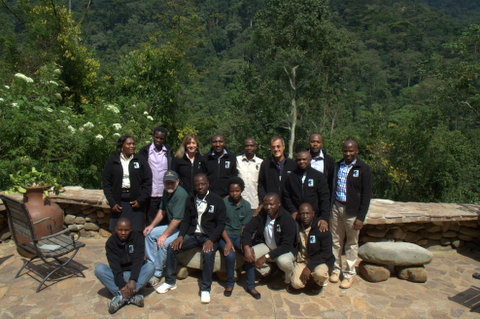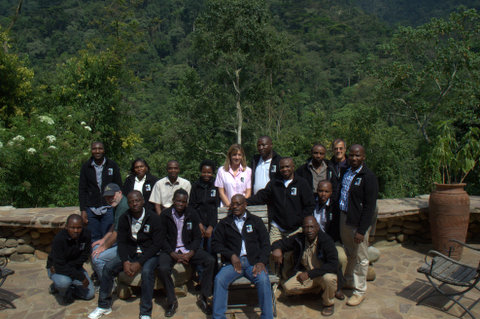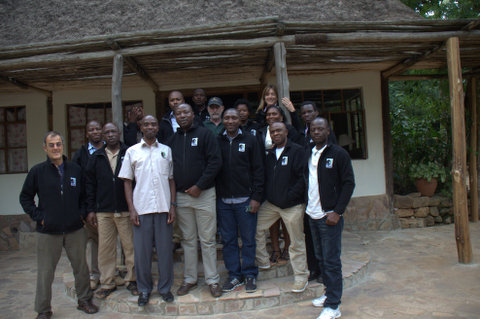Gorilla Doctors Staff Gather for Planning and Rejuvenation
By Gorilla Doctors Staff on Tuesday, March 17th, 2015 in Blog.By Kirsten Gilardi and Jaco Homsy
 Nearly our entire Gorilla Doctors staff – 16 of us, from Rwanda, Uganda, DRC and the US – came together March 8-9, 2015 for a retreat at the beautiful Bwindi Lodge in Buhoma, Uganda. Our objectives were to conduct a “check-up” on Gorilla Doctors: to take our temperature and measure our pulse and respiratory rate as an organization to collectively agree on what we are doing well and what we would like to do better. Strategy sessions were interspersed with breaks for meals and conversation, and the peaceful surroundings of Bwindi Impenetrable National Park helped us get away from the challenges of our daily jobs and instead inspire one another to envision the future of Gorilla Doctors.
Nearly our entire Gorilla Doctors staff – 16 of us, from Rwanda, Uganda, DRC and the US – came together March 8-9, 2015 for a retreat at the beautiful Bwindi Lodge in Buhoma, Uganda. Our objectives were to conduct a “check-up” on Gorilla Doctors: to take our temperature and measure our pulse and respiratory rate as an organization to collectively agree on what we are doing well and what we would like to do better. Strategy sessions were interspersed with breaks for meals and conversation, and the peaceful surroundings of Bwindi Impenetrable National Park helped us get away from the challenges of our daily jobs and instead inspire one another to envision the future of Gorilla Doctors.
Special thanks to Praveen Moman and his staff at Bwindi Lodge for making our stay so comfortable and pleasant and rejuvenating.

Also a special thanks to Dr. Jaco Homsy, MD, MPH, who volunteered to facilitate our retreat. Jaco wrote an important report in 1999 called “Gorilla Tourism: How Close Can We Get?” which set standards for gorilla visitation that would minimize the threat of transmission of human diseases to gorillas. Fifteen years later, we asked Jaco to work with our team, and here is what he had to say about his experience:
“After more than 15 years since first reviewing the gorilla tourism rules, facilitating the March 2015 Gorilla Doctors (GD) retreat in Bwindi National Park was a fantastic opportunity to revisit the many issues we raised back in 1999 in the prospect of a growing gorilla tourism industry in Uganda, Rwanda and DRC. Fast forwarding 15 years later, gorilla tourism has not just grown, it has exploded! I was simply amazed to see how much has been achieved, learned, and discovered since the Gorilla conservation program started. It is clear that far from being resolved, the threat of disease transmission – both from humans to animals and vice versa – remains a critical risk to the survival of mountain gorillas as the pressure from tourism and other human activities in and around the parks never abates. The discussions we had with the veterinarians, administrators and leaders of GD during the retreat confirmed the vital role they play in ensuring not only that our two species can coexist and the gorillas can survive, but also hopefully that they can bounce back to sustainable levels in spite of the pressure they endure.”
“Thanks to GD’s work and collaboration with multiple stakeholders in and outside the parks, many of the rules that were based on assumptions and limited experience in 1999 are now rooted in increasingly solid evidence. In particular, research projects under the One Health approach that GD is spearheading in the region are yielding extraordinary results. And the results of this holistic effort are there to see: the gorilla population has increased, gorilla tourism is booming, and the communities around the park have grown and developed in many innovative and exceptional ways. Needless to say, if it wasn’t for the incredibly inspiring work of the gorilla conservation community in which GD plays a unique role, we and the gorillas wouldn’t be there. I am looking forward to continue my small contribution to this remarkable endeavor.”



 Donate
Donate